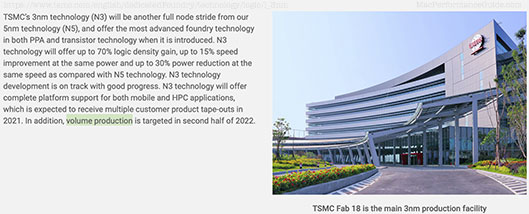Can the Apple M1 Max chip be Scaled to 25 CPU Cores and 80 GPU Cores by late 2022 via TSMC 3nm Technology?
Reader Roy P writes in reference to the cited AnandTech.com article:
What that means is, the 5 nm process is truly another generation, well beyond 7 nm. Meaning, they didn’t do a typical intermediate step in migrating towards the next node, like slightly shrinking the polygons, but mainly achieving smaller transistor channel lengths by over-etching the grate Poly. That does get you smaller transistors, but the pitch at which the lines are drawn are still 14 nm or maybe 13 nm, so the overall die size does not shrink much.
With this 5 nm process, I don’t know if the pitch is really 10 nm or something more relaxed than that, like 11 or 12 nm, but it is not a 7 nm design rules (i.e., 14 nm pitch) + aggressive etch. It’s very clear that the M1 Max has a significantly larger transistor count at a considerably smaller overall die size, and that is really impressive.
Looking at the TSMC site, it’s very clear that they are very confident about a 3 nm process, and also, they are saying it will be a full node, no Mickey Mouse partial node. If that’s true, here’s very simple, quick math, no different from estimating the pixel count given a sensor size:
 Die size vs 7nm, 5nm, 3nm process
Die size vs 7nm, 5nm, 3nm processIf TSMC can maintain a node-to-node 2.5x increase in transistor count, you’re looking at a lot of cores. Even a simple doubling would still accommodate a lot more cores, on board DRAM, etc.
This is really spectacular. The saddest part of it is, such a huge part of the technology TSMC has came from UC Berkeley, including all their FINFET stuff. It has been here, languishing in the public domain, for years. Intel did not take advantage of it because of internal arrogance and incompetence, and the other semiconductor companies didn’t take advantage of it, because they could please Wall Street more by outsourcing their fabrication and test to TSMC.
UPDATE/REVISION from Roy P: The key word is “targeted”. That means add 1-2 years. I had not read what they had said about their 3 nm process, but looking at the text below, “N3 … will offer up to 70% logic density gain” – so that means forget the doubling or 2.5x increase in transistor count that I had in my spreadsheet. Going from 5nm to 3nm, it won’t be as dramatic as going from 7nm to 5nm. So if they say up to 70%, it’s probably more like 50-60% for random logic, but even giving them the full benefit of doubt, we’re probably looking at something like 90+ billion transistors.
[DIGLLOYD: I'm not following this logic: with the same area, 5/3 = 1.66. Squaring that, we get 2.75X more circuitry in the same area]
Exactly how many CPU cores that translates to will depend on how much of the 57 billion transistors today is in the non-CPU core circuitry, or how many transistors there are in a CPU core. That would be hard to figure out, but a doubling should be easily possible, maybe even a quadrupling of CPU cores eventually from today’s M1 Max. But 2022 seems too ambitious.
MPG: Intel must be extruding bricks at this point. PC users will be suffering terrible cognitive dissonance as even the current M1 Max performance/value metrics undergo a sea change relatie to Intel solutions.
The TSMC “volume production” comment means that in theory, we could be looking at a 25-core CPU count, and an 80-core GPU count by mid 2022—2.5X what the Apple M1 Max chip can do. Intel would be perhaps 3 or even 5 years behind or so, most likely. Would you buy Apple or Intel stock, given that?
Even backing of the 2.5X figure to only 2X: 20 CPU cores and 64 GPU cores would leave all Intel-based solutions in the dust—4 cylinder engines in a 12-cylinder world (or maybe an electric-drive world). Now if Apple can only unf*ck its software development qualitiy.
Reader Shameer M writes:
Mark Gurman (Bloomberg Tech reporters) posted an article earlier this year with respect to new Macs that Apple would be coming out in 2021 and in 2022. This is what he said about the new 14" / 16" MBP back in May;
"For the new MacBook Pros, Apple is planning two different chips, codenamed Jade C-Chop and Jade C-Die: both include eight high-performance cores and two energy-efficient cores for a total of 10, but will be offered in either 16 or 32 graphics core variations."
Jade C-Die (10 core CPU and 32 core GPU) is what we now know as M1 Max and Jade C-Chop (half of the GPU cores "chopped" off) is M1 Pro. Here is what he goes on to say about the new Mac Pro coming out some time next year:
"Buyers of the high-end Mac Pro desktop planned for next year will likely have a choice of two processors that are either twice or four times as powerful as the new high-end MacBook Pro chip. Codenamed Jade 2C-Die and Jade 4C-Die, a redesigned Mac Pro is planned to come in 20 or 40 computing core variations, made up of 16 high-performance or 32 high-performance cores and four or eight high-efficiency cores. The chips would also include either 64 core or 128 core options for graphics."
Jade 2C-Die is essentially two M1 Max SoC's on a single die or package and Jade 4C-Die is four M1 Max SoC's on a single die or package Apple (AAPL) Readies MacBook Pro, MacBook Air Revamps With Faster Chips - Bloomberg Here is a diagram someone made to highlight it better. city-of-chiplets.png (4012×7795) (hypercritical.co) If Gurman is right and the new Mac Pro is coming out next year, I don't think the processors that power it will be built on a 3nm node since TSMC has delayed 3nm products shipping to clients beginning in 2023 TSMC Roadmap Update: 3nm in Q1 2023, 3nm Enhanced in 2024, 2nm in 2025 (anandtech.com)
MPG: all Intel-based solutions will look like dinosaur fossils if the M1Max 2X and M1Max 4X arrive next year as described above.

 diglloydTools™
diglloydTools™













